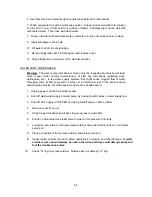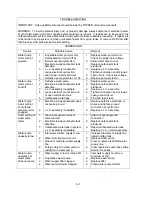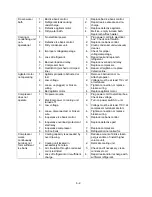
No syrup being
dispensed
1.
2.
3.
4.
5.
6.
7.
8.
Syrup container empty.
Syrup lines crimped.
CO2 cylinder empty.
QCD of syrup installed in-
correctly.
Low-pressure regulator defective
or plugged.
Syrup disconnect not attached
correctly.
Loose electrical connection of
syrup solenoid and or open
electrical connection.
Frozen water bath.
1.
2.
3.
4.
5.
6.
7.
8.
Replenish syrup supply.
Straighten syrup lines.
Change CO2 cylinder.
Re-install QCD correctly.
Repair or replace low-pressure
regulator.
Lubricate and attach.
Tighten connection and/or repair
open circuit. Check proper
voltage.
See “Frozen Water Bath”.
No water being
dispensed
1.
2.
3.
4.
5.
6.
7.
Plain water inlet supply shutoff
closed.
Water filter fouled/clogged.
Pinched or crimped line.
Loose electrical connection, 24
volt.
Water pump motor worn out or
damaged.
Water pump worn out or
damaged.
Frozen water bath.
1.
2.
3.
4.
5.
6.
7.
Open plain water inlet supply line
shut off valve.
Replace filter or cartridge.
Repair defective line.
Tighten connection and or repair
open circuit.
Replace motor.
Replace water pump.
See “Frozen water bath”.
Volumes of
CO2 to low in
finished product
1.
2.
3.
4.
High-pressure regulator out of
adjustment.
CO2 cylinder empty.
Water, oil, or dirt in C02 supply.
Temperature above quality limits.
1.
2.
3.
4.
Adjust high-pressure regulator as
instructed.
Replace CO2 cylinder.
Clean contaminated CO2 system,
(lines, regulator, etc.) and sanitize
as instructed.
See refrigeration/machine
specifications vs. volume
requirements.
Dispensed
product makes
foam as it
leaves
dispensing
valve
1.
2.
3.
4.
Pressure of CO2 to high.
Syrup over-carbonated with CO2.
Dirty nozzle and valve cavity.
Temperature above quality limits.
1.
2.
3.
4.
Adjust high-pressure regulator as
instructed.
Remove syrup tank quick
disconnects. Relieve pressure;
shake tank vigorously, as
necessary to remove over-
carbonation.
Clean contaminated nozzle and
sanitize as instructed.
See refrigeration/machine
specifications vs volume
requirements.
Dispensed
product comes
out clear but
foams in cup or
class
1.
2.
Oil film or soap scum in cup or
glass.
Ice used for finished drink is
subcooled.
1.
2.
Use clean cups and glasses.
Do not use ice directly from
freezer. Allow ice to become
“wet” before using. Note;
crushed ice also causes foaming
of beverage. Carbonation is
released on sharp edges of the
ice.
6-4






































